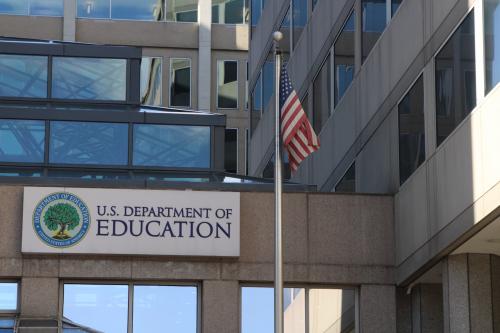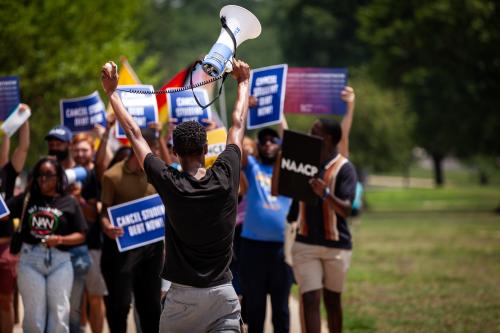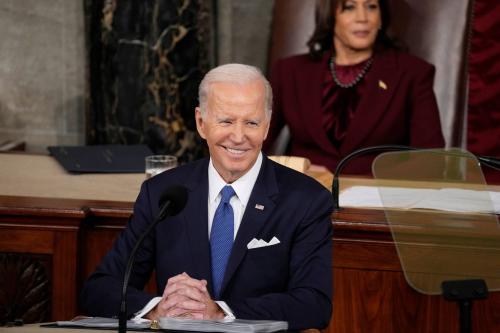On a Saturday last February, Ginny Markell, the president of the National PTA gathered with a dozen other leaders of the organization in a Holiday Inn in Southgate, Mich. They had traveled to the Detroit suburb to pledge, as part of a new “urban initiative,” to help get parents more involved in Detroit’s public schools, where the dropout rate is pushing 40 percent and where membership in local PTA’s has plunged to 1,200 from 60,000 in the early 1970’s in the wake of white flight and intensifying poverty.
The National Congress of Parents and Teachers, as the National PTA is formally known, is the umbrella organization of the nation’s 26,000 local PTA chapters. It had invited dozens of Detroit civic and educational leaders to Southgate. But the majority of them did not show up—not the city’s school board members, not representatives of the powerful Detroit Federation of Teachers, representatives of the Detroit N.A.A.C.P., or of the city’s Latino family services agency. Detroit’s schools chief at the time, David Adamany, had a scheduling conflict. So Ms. Markell and the other leaders made their pitch for a greater parental presence in Detroit’s schools mostly to themselves.
The hapless event was a measure of how tough things have become for the nation’s largest and most influential parents’ organization. Membership in the local parent groups that have long been as much a part of the American cultural landscape as Little League baseball and Fourth of July parades has plunged not only in Detroit but nationwide—to 6.6 million today from a peak of 12 million in 1966. At the same time student enrollment has risen to 52 million from 31 million. The surge of women into the workplace and a sharp rise of single-parent families have been big factors in the decline. So has a general decrease in civic activities, chronicled by Robert Putnam, a political scientist at Harvard, in his book “Bowling Alone.”
But there are other reasons for the PTA’s plight. As the Detroit debacle suggests, the organization has largely failed to attract the minority families who account for an increasing percentage of public-school students. And its national leadership has tended to defend public education’s performance rather than push for improvement, leading to the defection of many local parent groups.
Furthermore, studies show that new-style partnerships that give parents a substantial stake in their children’s schools are successfully drawing parents from a wide range of backgrounds into students’ educational lives and raising student achievement. Yet most local PTA’s, critics charge, have clung to an antiquated model that relegates parents to the periphery of school life. That stands in stark contrast, they say, to the new school-parent partnerships at such schools as Patrick O’Hearn Elementary School in Boston, where parents play a role in nearly every aspect of school life.
Because of its troubles, the organization is struggling financially. It recently cut its budget by 25 percent and purged nearly a third of the staff at its national headquarters in Chicago.
Demographics have been particularly hard on the PTA. Only 20 percent of American students live in two-parent households with a single wage earner today, down from over 50 percent during the group’s heyday in the 1960’s. That means it is a lot harder for parents to make time for their children’s schools. The Department of Education reports that 28 percent of parents do not attend a single parent-teacher conference during the school year and that 61 percent never volunteer in schools.
But it is also true, people on both sides of the issue say, that the organization is out of step with many parents’ demands for change in public education today, generally rejecting the contention that public schools are doing a poor job of educating many students. And critics charge that the organization has worked with groups representing public educators to slow the pace of change at both the state and federal levels.
The PTA has particularly strong ties to teacher unions. Charlotte Frass, chief Washington lobbyist for the American Federation of Teachers, said, “We often lobby together.” Ties are even close to the nation’s other leading teachers union, the National Education Association. One of the PTA’s three Washington lobbyists is married to an N.E.A. lobbyist, and from the founding of the PTA’s Washington legislative office in 1978 through 1993, its lobbyists were housed in rent-reduced offices in the N.E.A.’s headquarters a few block from the White House.
Like the unions, the PTA pushes relentlessly for more federal education financing. Earlier this year more than 200 PTA political activists descended on Capitol Hill, urging members of Congress to back the Clinton administration’s proposals for $25 billion in federally subsidized school-construction bonds and $5 billion in grants to reduce public school class sizes.
The organization rejects the belief of many would-be school reformers today that public schools would work harder to improve if they had to compete for students and financing. “There are always winners and losers in a marketplace,” Maribeth Oakes, the PTA’s legislative director, said, “and we shouldn’t have an education system where there are losers.” The group has backed charter school laws only if they require that the hybrid public schools report to traditional school boards. Critics contend that strips the schools of the very independence that is the basis of the charter concept.
In some instances, the PTA’s defense of public educators seems to have put it at odds with parents’ interests and with its own goal of increasing parental participation in schools.
In a forthcoming book on the PTA, a critic, Charlene Harr, president of the conservative Education Policy Institute in Washington, says the group’s pro-teacher stance goes back to the 1960’s, the early years of collective bargaining by teachers.
Similarly, PTA officials say they are concerned about the quality of many charter schools, even though studies have shown that parents who are able to select their children’s schools tend to be more active in school life.
Members of Congress allied with the teacher unions and other public educator groups speak in flattering terms of the PTA. “They’re the good guys,” said Suzanne Day, a former aide to Senator Christopher J. Dodd of Connecticut, the ranking Democrat on the Senate Subcommittee on Children and Families.
BUT the organization—one long associated with nothing more controversial than bake sales and pot-luck dinners—has come under increasing attack from critics including Representative William F. Goodling of Pennsylvania, the Republican who is chairman of the House Committee on Economic and Education Opportunities, as well as a former president of a local PTA. “I don’t know why they even have ‘P’ in their name,” he said. “They don’t represent parents. They represent whatever the major education groups want, which is the status quo.”
That has not been the case on children’s welfare issues. The organization has been a leading crusader for the protection of children since its founding as the Congress of Mothers in 1897 by a group of Washington socialites that included the mother of William Randolph Hearst, the publisher. Phoebe Hearst’s fortune, earned in the California gold rush, financed the fledgling organization.
By the time the organization changed its name to the National Congress of Parents and Teachers and started referring to itself as the National PTA in 1924, it had played a major role in the passage of child-labor laws and in the creation of the juvenile justice system. It helped create the federal school lunch program in the 1940’s, and it helped organize the testing and distribution of the first polio vaccines in the 1950’s. Today the organization is active in the antismoking and television-ratings crusades, among others.
But the politicking on school issues in general and the tepid response to what is known as reform in particular have in recent years contributed to a backlash against the group.
“I don’t have time or any interest in lobbying,” said Patti White, a paralegal and co-president of the parents association at Cherry Brook Primary School in Canton, Conn. “We can barely get enough people to run a book fair.” Parent loyalty to the national organization is so soft that when it raised its dues by 25 cents in 1995, to $1, the PTA’s membership shrank by nearly 400,000. Pressed by the current troubled finances, the organization’s leaders in June asked delegates to the national convention to double the national dues to $2. Instead the delegates voted to raise dues to $1.25 next April, leaving the PTA’s financial plight largely unaddressed. Local PTA’s charge an average of $15, of which $2 or $3 are sent to the state organization and $1 goes to the National PTA.
Many parents, including the 250-member organization at Cherry Brook, which disaffiliated from the PTA last January, are starting independent groups with strictly local priorities. As a result, fewer than a quarter of the nation’s schools today have parent groups linked to the National PTA.
But these new single-school organizations tend to be, like most local PTA’s, focused on fund-raising.
Experts, such as Anne Henderson, a consultant at New York University’s Institute for Education and Social Policy, and Joyce Epstein, director of the Center on School, Family, and Community Partnerships at Johns Hopkins University, say that book fairs, spring carnivals and other traditional PTA-sponsored events contribute to a sense of community in schools and raise helpful funds. But they argue that the relationship between parents and schools should move far beyond fund-raising.
They say that schools should share with parents everything from course content to homework assignments and sample test questions, and that parents ought to take school-friendly steps like restricting television watching, carving out quiet places and regular times for homework, discussing school work and reading with their children. And it involves parents being in schools // as PTA-style volunteers, but also as tutors and lecturers, as educational advocates for their children and as members of committees that set school policies.
In some places parents are even taking on a direct role in managing public schools, as parents do in private schools as trustees. Chicago’s 597 schools, for example, are run by councils composed of six parents, two teachers, the principal and two community representatives. The councils have the authority to hire principals, help shape budgets and chart changes.
A wider, more active role for parents has the potential to help students in numerous ways. Studies show, for instance, that teachers have higher expectations of students whose parents are active in their children’s schooling and that such students are likely to work harder because they sense their parents care. Ms. Epstein found in a study of nearly 700 Baltimore eighth-graders that requiring students to discuss regularly with a parent some aspect of the writing instruction they received in school resulted in higher scores on writing tests and more enthusiastic writers.
There also tends to be substantially less tolerance for slack teachers in schools with activist parents. As Ms. Henderson put it: “Parents aren’t going to make a difference if teachers don’t know how to teach, but with active parents a school’s a lot less likely to have teachers who can’t teach.”
Seated in her office at the National PTA’s headquarters on the 21st floor of a modernist Chicago skyscraper, the president, Ms. Markell, a daughter and granddaughter of PTA activists, is unapologetic about the National PTA’s politics. PTA locals “expect us to have a strong voice at the national level,” she said. “We’re delighted they’re involved in their schools,” she said of parents leaving the PTA to establish parent councils and other independent groups. And although Ms. Markell, a registered nurse on leave from teaching health science at a suburban Oregon high school, is an N.E.A. member herself, she insists that the PTA “isn’t beholden to teacher unions.”
But Ms. Markell acknowledges the inadequacy of the often singular focus on fund-raising at the local level. Under her leadership, the group has encouraged its chapters to move beyond bake sales by developing a more comprehensive local PTA model built on Ms. Epstein’s ideas.
But its cash shortage makes the task of pushing 26,000 affiliates in new directions daunting. To help pay for a new 10,000-page Web site to promote the new model, the national organization, a crusader against commercialism in the classroom, resorted to licensing the use of its name; Office Depot, for instance, was “the official school supply headquarters of the National PTA” until the membership protested last year.
THE rise of the parent-led school councils in Chicago reflects the price PTA’s are paying for their soft stance on school accountability. The city’s PTA’s fought the legislation that established the councils—only to suffer “big” membership losses once the councils were in place, said Pamela J. Grotz, the National PTA’s executive director. A study of the councils by a consortium of Chicago-area universities found that they had generally attracted the city’s better educated parents and had “contributed productively to their schools in many small, but important ways.”
Critrics say that nothing better reflects the failing of the traditional PTA model than the National PTA’s urban initiative, begun three years ago in an effort to diversify the organization’s largely white, suburbanite membership. Two years of work in New York, Boston and Philadelphia produced only a single new chapter, at the Patrick Lyndon Pilot School in the West Roxbury section of Boston.
There is a big role for PTA’s to play in rallying parents to the cause of school improvement. But critics say that unless the National PTA relinquishes its defense of the educational status quo, and unless local chapters define parent involvement far more ambitiously, the century-old cultural icon is likely to continue its decline, a consequence, they say, that would make little difference in the schools.
A Local Success
There is a nascent movement among public schools to build partnerships with parents to give them a much bigger presence in the life of their children’s schools than they have under the traditional PTA model. A look at one school in the vanguard of the movement, Patrick O’Hearn Elementary School in the Dorchester neighborhood of Boston, shows why the movement is growing.
On a March night parents and their children crowded into the 1950’s-era single-story hexagonal brick building for “family math night,” part of a wide-ranging parent-educator partnership at a school in an area its principal calls “the Bronx of Boston.” Three-fourths of the students are African-American or recent immigrants from Asia, Africa and the Caribbean, and two-thirds take part in a federal lunch program for the poor.
In O’Hearn’s cafeteria, kindergarten children and their parents constructed geometric shapes out of gum drops and toothpicks and then measured them. Parents in a nearby classroom tried sample questions from the Massachusetts fourth-grade math test, and in another, students participating in a “paper Olympics” predicted the distance they could throw paper javelins. The purpose of the exercise was to introduce parents to a new state math curriculum in a nonthreatening way. “Big, ritualistic encounters like back-to-school nights turn parents off,” said Bill Henderson, the school’s 50-year-old principal, a Yale graduate.
Mr. Henderson begins building bridges to parents early. Even before new students walk through the door a cadre of parent volunteers travels to the students’ homes to welcome them and their parents (in their native language if it is not English), talk about the school and its priorities and give the new students a book, which symbolizes the school’s strong dedication to reading.
O’Hearn also signals to parents that they are part of the educational equation by requiring them to sign “reading contracts” four nights a week attesting that they have read with their children. Parent volunteers contact those who shirk the responsibility, and they have been known to do the persuading over a pizza.
To help draw in as many parents as possible O’Hearn asks them to serve as after-school tutors, “guest readers,” substitute teachers, parent-to-parent volunteers and organizers of traditional fund-raisers. They can even be school policy makers. Six parents sit with five teachers and Mr. Henderson on O’Hearn’s “school site council.” The panel helps hire the school’s staff, select textbooks and set spending priorities. Last December it voted to hire a former O’Hearn parent to tutor half a dozen struggling students after school. A school employee organizes workshops for O’Hearn parents.
Such strategies have paid big dividends at O’Hearn. Over 95 percent of parents regularly sign their children’s reading contracts, and attendance at parent-teacher conferences averages an impressive 90 percent, in part because Mr. Henderson requires that parents pick up their children’s report cards in person. “They’re as invested as we are; the kids are getting a strong signal that school’s important,” said Rosemary O’Brien, head of the O’Hearn faculty senate.
Active parents at O’Hearn have also made teaching at the school more attractive. “Parents understand what’s required and what they can do to help,” said Gail Harris a former O’Hearn kindergarten teacher who has a son and daughter at the school. “Discussions about kids are easier when their parents are here frequently. They are more comfortable, more open exchanges.” The school, which has 220 students, has lost only four teachers in the last eight years, less than half the aver-age teacher-turnover rate of Boston’s other public schools.
Most important, while O’Hearn’s parents have been mobilized, the school’s performance has improved. In the last decade math and reading test scores have climbed from near the bottom of the city’s 80 elementary schools to near the top, despite a large percentage of disadvantaged students and many with learning disabilities.
The lessons from O’Hearn, in the view of the PTA’s critics, is that most schools and their PTA’s simply do not work hard enough or smart enough to make parents part of the educational process and that given the right opportunity and encouragement struggling urban parents no less than their affluent suburban counterparts readily contribute to their children’s educations.



Commentary
The Plight of the PTA
January 7, 2001